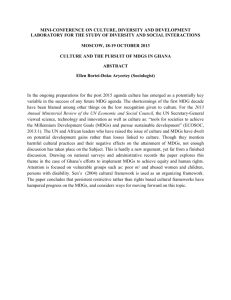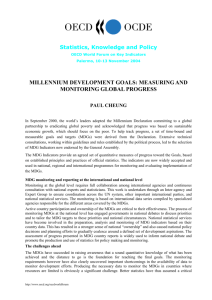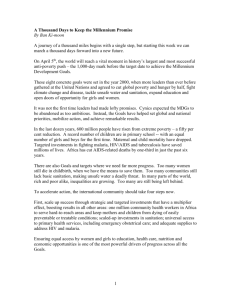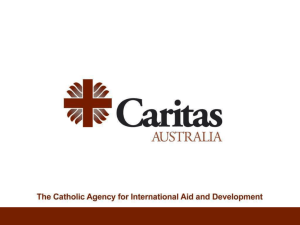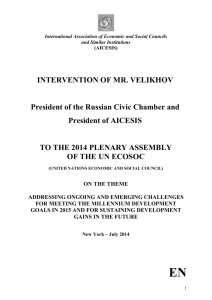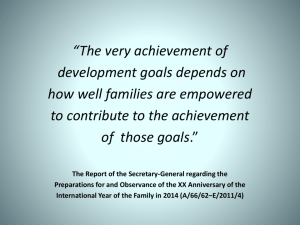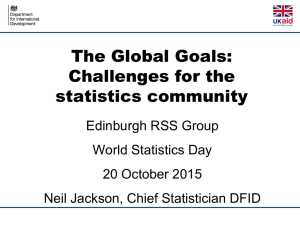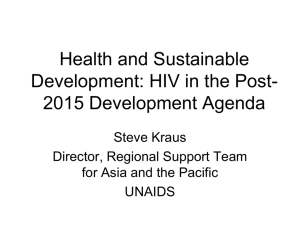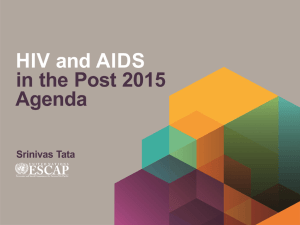The United Nations' MDG Strategy
advertisement
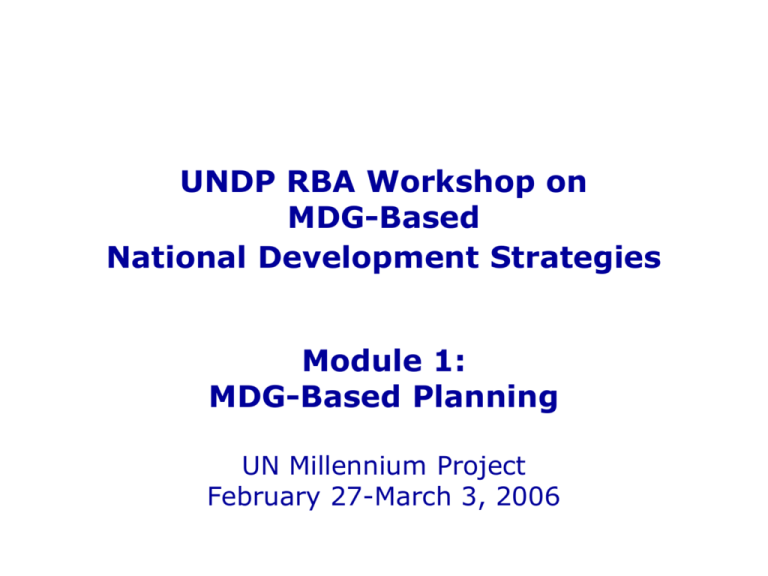
UNDP RBA Workshop on MDG-Based National Development Strategies Module 1: MDG-Based Planning UN Millennium Project February 27-March 3, 2006 Agenda 1. The MDGs can be met in Africa 2. What is needed to achieve the Goals 3. Integrating the MDGs into national development strategies 2 The MDGs are Shared Goals… International agreements (such as Monterrey) provide the right framework for the MDGs – – – – Low income countries need increased ODA to meet Goals Countries are responsible for good governance Private flows important but only partial substitute Market access critical for long-term economic growth All countries reaffirmed their commitment to the MDGs at the World Summit 2005 The MDGs can be met within existing commitments by rich and poor countries 3 … That Remain to be Operationalized Currently the MDGs are aspirations, not operational targets: – Countries do not plan systematically to achieve the MDGs – Aid is not provided based on countries’ needs – The international development system is not goal oriented 4 Africa’s Special Needs: Look Beyond the Standard Diagnosis of Poor Governance Africa faces unique structural constraints, e.g.: High disease burden Dependence on low-productivity rain-fed agriculture Poor transport infrastructure Few navigable rivers Small internal market size Low population density Population living far from the coast Governance alone does not explain low growth in Africa Each of these constraints can be overcome through targeted public investments Trade plays a complementary role for long-term economic development 5 The Economic Consequences of Africa’s Special Needs Poverty traps result from combination of three factors: 1. High minimum capital threshold 2. Low savings rates 3. High population growth (“capital widening”) Poverty Trap Above the Threshold k k k’ k’ (capital per person) time time time 6 Achieving the MDGs is Possible Countries can end poverty trap through combination of: 1. Broad-based public investments at scale in health, education, agriculture, infrastructure, and environmental management 2. Sound policies and governance including good economic management 3. Improved access to international trade There is no “magic bullet” – each input is necessary 7 The MDGs are Affordable Typical low-income country needs: $110 p.c. per year through to 2015 To meet the MDGs, low income countries will need more aid and debt relief, despite increased domestic resource mobilization Macroeconomic stability can be maintained if aid is predictable, grants-based and targeted to investments At the global level MDGs are affordable within existing commitment of 0.7% target 8 Existing Commitments are Sufficient and Must Now be Implemented Unprecedented technical consensus on what is needed to achieve MDGs (HDR 2005, GMR 2005, Africa Commission, Millennium Project) 24 May 2005 agreement of EU-15 to reach 0.7 by 2015 G8 decisions to double aid to Africa, cancel debt, support AIDS treatment World Summit call for MDG based development strategies by 2006 Implementation: Integrate MDGs into national development strategies Map out the practical investments needed to achieve the Goals 9 Agenda 1. The MDGs can be met in Africa 2. What is needed to achieve the Goals 3. Integrating the MDGs into national development strategies 10 Meeting the MDGs Requires Growth and Investment Growth is necessary, but not sufficient for MDGs – Some MDGs require direct investments regardless of economic growth (e.g. maternal mortality, environmental sustainability) – Reaching the poor & reducing inequality requires direct investments in people, infrastructure & environment Public investments in MDGs are critical for growth – Private sector led growth requires minimum standards in health, education, infrastructure, etc. – Direct investments must complement good economic policies 11 Integrated Investment Strategies to Meet the MDGs All necessary inputs need to be covered Investment strategies need to be integrated and outcome-focused The UN Millennium Project proposes 7 investment clusters for the MDGs: 1. 2. 3. 4. 5. 6. 7. 8. Rural development Urban development Health systems, including HIV/AIDS Education Gender equality Environment Science, technology and innovation Cross-national infrastructure 12 MDG Investments Can Build Absorptive Capacity Capacity development comprises long-term investment strategies in 1. Human resources – Pre-service training – In-service training – Review of salaries and benefits 2. Infrastructure – Capital costs – Operating expenditures 3. Public management systems – Civil service reform – Equipment – IT services 13 Agenda 1. The MDGs can be met in Africa 2. What is needed to achieve the Goals 3. Integrating the MDGs into national development strategies 14 Principles of Development Strategies that are MDG-based Typical strategy today MDG-based development strategy MDG target Level of MDG progress ? 1990 MDG Base Year 2005 YEAR 2008 2015 MDG Target Deadline 15 1990 MDG Base Year 2005 2008 YEAR 2015 MDG Target Deadline The Operational Framework for Achieving the MDGs Countries align national development strategies with the MDGs, including integrated investment strategies across sectors The international community supports these strategies with adequate development assistance As requested by governments, UN system provides technical support in strategy design and implementation 16 Aligning National Strategies with a Goalsbased Approach How can the MDGs be translated into operational targets? How can sector strategies based on the MDGs be integrated into the PRSP/national development strategy? How would the MTEF and annual budgeting processes need to change to reflect the country’s commitment to the MDGs? How can the UN Country Team align its technical work with supporting governments in preparing and implementing MDG strategies? 17 Five Core Features of an MDG-based Strategy 1. Ambition: National targets are at least as ambitious as MDG targets for 2015 2. Scope: The range of sectors identified is broad enough to achieve all the MDGs 3. Rigor: For each sector, the strategy is based on a detailed, bottom-up needs assessment 4. Timeline: The medium term strategy is nested in a 10-year MDG framework 5. Financing: Financing strategy is determined in line with each country’s needs 18 Five Key Messages for This Workshop 1. Countries in sub-Saharan Africa are caught in poverty trap 2. The MDGs provide an operational framework for ending the poverty trap & empower African countries to ask the new question 3. In the short term countries need more & better aid to end aid dependency 4. Achieving the MDGs & ending the poverty trap requires detailed quantitative analysis 5. The UN system is uniquely placed to support countries technically, but needs to build up the required technical expertise 19
